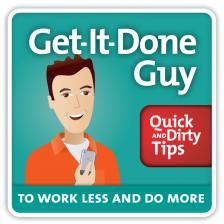Boost Your Performance by Finding a Bottleneck
When you identify the choke points in your most important deliverables, you can eliminate bottlenecks and boost your productivity.

First, let’s get clear on what a bottleneck is. It’s not a species of tropical bird. Any system, like a person, or a company, or a computer program, is made up of lots of parts. Those parts all work at different speeds. But at any given moment, there’s one part that is maxed out. It’s called the bottleneck. It’s working as hard as it can, and the rest of the system is oriented around it.
I’ve never been on the Autobahn, but I’ve heard stories about this highway in Germany with no speed limit, where even light can go as fast as it wants. On the Autobahn, you don’t just put the pedal to the metal, you put the pedal through the metal (being careful not to cut your foot on the torn pieces of metal, of course).
Never miss another tip. Sign up for our Quick and Dirty newsletters to get all your favorite tips delivered straight to your inbox. Sign up now.

The bottleneck can change depending on circumstances. On the Autobahn, the accelerator is your bottleneck. On a freeway, the posted speed limit is the bottleneck; drive too fast and you’ll be stopped by the police. On a dirt road, the road quality is a bottleneck; drive too fast and your wheels will fall off.
Now here’s the cool thing about bottlenecks: if you want to change how fast a system operates, starting with the bottlenecks is your highest-leverage place to start.
You Have Bottlenecks Everywhere
Bottlenecks are everywhere in your life. They have to be. Bernice is pulling together the finances for her two Green Growing Things plant stores. She’s impatiently waiting for Melvin and Europa to get her the numbers. From Bernice’s point of view, assembling the numbers is the bottleneck. She can tweak the bottleneck by finding ways to assemble the numbers that don’t involve waiting for Melvin and Europa.
Europa, of course, is diligently working to assemble the numbers. Bernice started the first store with a very informal approach. Each purchase is just noted on an index card and tossed into a brown cardboard box beneath the checkout counter. She said, “A cash register, being a man-made device, does not do proper honor to the Goddess. Index cards are made from trees, which is only fitting.” Assembling the numbers requires picking up 10,000 index cards, orienting them correctly, and then adding the numbers. From Europa’s point of view, the bottleneck is organizing and adding up the recorded numbers. Now that Bernice no longer works the cash register, Europa plans to fix the bottleneck by purchasing an electronic cash register that automatically tracks and totals purchases.
You Can Change Bottlenecks

When you change a system or operate it differently, the bottleneck shifts. Back on the Autobahn, you can see space aliens hovering over the road using a tractor beam to pull cars up into their intergalactic saucer to perform unspeakable experiments on the occupants. Being a smart person, you slam on the brakes. Hard.
Now the bottleneck has changed from the accelerator to the brakes. If Europa buys a new cash register for the store, next year there will still be a bottleneck to collecting the numbers. It will just be a new one. Perhaps next year, the bottleneck will be the fact that the new-fangled cash register exports its data in a format that requires a $10,000 software package to interpret. The bottleneck has changed from sorting index cards to muddling through the convoluted menus of a poorly designed software package.
Examine Your Bottlenecks
Now it’s your turn to think through the major tasks in your work life. What are the major deliverables you’re responsible for? If you’re a programmer, it’s lines of working code. If you’re a marketing manager, it’s successful product launches. If you’re a publicist, it’s scheduling interviews. If you’re a bellman, it’s getting luggage to and from people’s rooms and keeping them happy and satisfied. If you’re a blogger, it’s writing blog posts.
Think through the steps that make up that activity. Identify the pieces that really limit the speed at which the activity can be done. Sometimes those pieces can’t be changed. If you’re a chef, properly cooking food takes a certain amount of time, and you can’t go any faster. But if you’re a bicycle messenger and your bike speed is the limiting factor, you might be able to change the gear ratio, buy a different bike, or choose a route that lets you pedal faster to get past your limits.
Skills Can Be Bottlenecks
Sometimes the limiting factor can be a skill. If you do a lot of typing in your job, pay attention to whether typing speed is a bottleneck for you. Some people type fast enough that composing their text is the bottleneck, but for others, it’s the typing itself that takes time. If you fall into that latter camp, consider taking a touch typing class. It will make a world of difference to your productivity at anything that requires typing.
It’s the same for reading. If you’re a reporter, or someone whose job demands reading a lot, a speed reading course might be in order. If you need to read for deep understanding, speed reading can be less useful because acquiring the deep understanding is the bottleneck. But if you’re reading to bring in information and find patterns, or identify important trends, speed reading might help.
Bottlenecks always exist. You fix one, and things get faster, but there’s still a bottleneck, it’s just somewhere else in the system. Sometimes, the bottleneck is physics, or biology, or something else that can’t be changed, and you can’t get any more performance unless you redesign part or all of the system itself. Get curious! Look around at the things you’re responsible for. Find the bottleneck and optimize it. By focusing your efforts on your bottlenecks, you’ll soon be working less and doing more.

Work Less, Do More, and have a Great Life!
Autobahn, Bottleneck, and Hand swiping credit card images courtesy of Shutterstock






